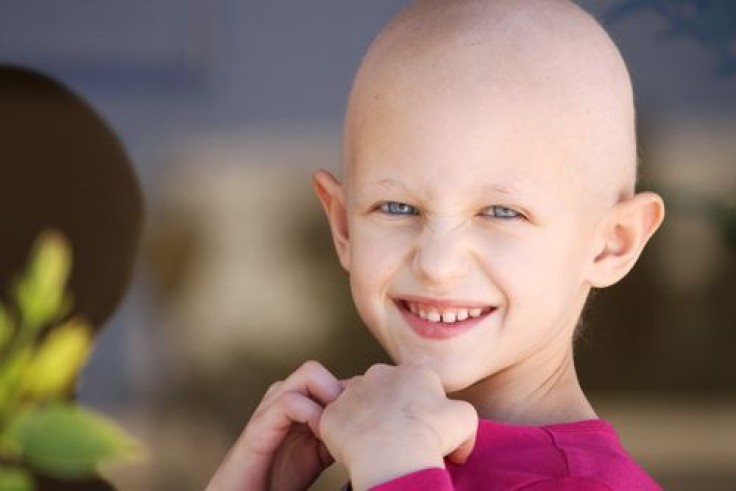Pediatric Leukemia Drug Treatment May Now Be Less Painful; IV PEG-Asparaginase Proven Safe And Effective

Children with acute lymphoblastic leukemia (ALL), the most common form of pediatric cancer, may now receive a safe and effective form of cancer treatment. The IV PEG-asparaginase — a bacteria-based enzyme — is found to remain longer in the blood stream of patients than its native form L- asparaginase, helping patients experience less pain and anxiety from treatment, according to a recent clinical trial.
The development of ALL usually starts in a child’s white blood cells — immature forms of lymphocytes in the bone marrow — where leukemia cells invade the blood fairly quickly and spread to other organs, says the American Cancer Society. The patient’s spleen, central nervous system, especially the brain, spinal cord, and testicles in males are often invaded by the cancer.
If ALL is not treated immediately, the cancer can be fatal within just a few months of diagnosis since it rapidly progresses. However, children with newly diagnosed ALL usually attain initial complete remissions in four to six weeks with up to a 99 percent survival rate. Treatment for ALL involves chemotherapy to kill leukemia cells with all chemotherapy stopping after two to three years of treatment. Usually radiation therapy can now safely be eliminated for the majority of children with ALL. Current research aims to improve ALL treatment by optimizing dosage and facilitating the scheduling of antileukemic agents based on the unique needs of the patient.
Presented at the 55th annual meeting of the American Society of Hematology (ASH), Dr. Lewis B. Silverman and his team of researchers sought to compare the native E.coli asparaginase delivered via intramuscularly (IM) and PEG-asparaginase, the polyethylene glycol conjugate of E.coli asparaginase, administered via IV. Five hundred and fifty-one patients with newly diagnosed ALL ages 1-18 years who achieved complete remission were eligible to participate in the randomized comparison of the two asparaginase injection preparations. The ALL patients were treated at 11 centers in the U.S. and Canada between 2005 and 2010 in the study.
These two preparations aim to deplete plasma asparaginase for leukemia patients. Normal human cells can produce their own asparagine, but for ALL patients the leukemia cells are not able to, and therefore become dependent on exogenous sources. Therefore, the depletion of plasma asparagine by asparaginase preparations kills the leukemia cells.
One dose of PEG-asparaginase (2500 IU/m2) was administered during the four-week multiagent induction phase with the total duration of the therapy lasting 25 months in the study. The researchers measured asparaginase activity by obtaining serum samples every six weeks prior to an asparaginase dose from both preparations.
The findings revealed 526 patients (95 percent) out of the 551, achieved complete remission. In the four-year follow-up, the survival rate was 86 percent for all patients, which is among the highest rates ever reported in a pediatric ALL trial. The researchers did not find a statistically significant difference in the survival rate between patients in the trial’s IV PEG-asparaginase and IM native L-asparaginase arms, with 92 and 90 percent, respectively. There was also no notable difference in the rates of allergic reactions, pancreatitis, or clotting for the patients. These are all potential side effects of L-asparaginase.
These results have become increasingly significant since the native L-asparaginase is no longer available in the U.S. "Demonstrating that this important agent can be safely administered intravenously should help to provide clinicians peace of mind that they can decrease patient discomfort without increasing risk," Dr. Silverman, director of the Hematologic Malignancy Center at Dana-Farber/Boston Children's Cancer and Blood Disorders Center, who presented the data on behalf of the Dana-Farber Cancer Institute ALL Consortium, said in a press release.
Not only does the drug treatment reduce pain and anxiety for patients, but it also remains in the blood stream longer than L-asparaginase, which means patients can be treated less frequently. The lowest concentrations of the drug in the blood of patients’ arm were nearly eight times higher than those in the IM native E. coli L-asparaginase group. IV PEG-asparaginase is as effective as and more toxic than its native form in children and adolescents, wrote the researchers.
St. Jude's Children's Hospital says about 3,000 children in the U.S. each year are found to have ALL with peak incidence occurring from 3 to 5 years of age. The pediatric cancer affects more boys than girls and occurs more frequently among whites than blacks. Ninety percent of children can be cured, and those who remain leukemia-free for 10 years or more are considered to be cured from the cancer.
To learn more about ALL current research, click here.



























